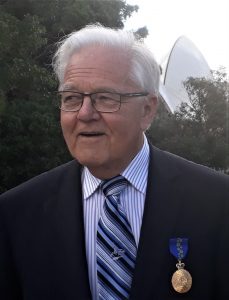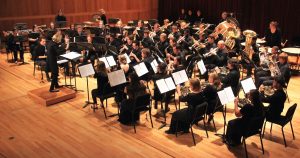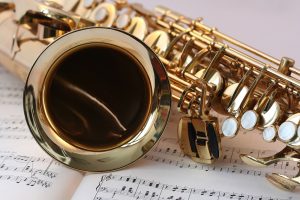by Russell Hammond
We’ve all got concepts – lots of them – and they can be a very useful teaching tool for music teachers and particularly for conductors of school orchestras, bands and jazz ensembles. The trouble is that most of us don’t recognise their value and our concepts remain virtually unused.

- Nobody owns a concept – you get concepts from other people. It’s called ‘gleaning’
- We’ve all borrowed or gleaned them from others or we’ve developed our own based on the teaching experiences we’ve had
- Build up your own ‘repertoire’ of concepts – write them down and start using them
- Use them often as you teach
- Always be consistent in the way you express them
- Reinforce them by using the same words and making the same gestures while you say them
- Repetition is a great way to teach. Don’t send confusing messages to your students
- Use catchy, short, easy-to-remember phrases that students will retain in their memory
- Teach your students how to apply that concept every time the same situation occurs – without having to be reminded.
Perhaps the best way to think about concepts is a concept itself
The Concept Concept:
What this means in musical terms is that if you only just teach a student to play one piece of music, all the student can do is play that piece of music. They have not learned any basic concepts which they can apply to all the other music they want to play.
If, while you are teaching them that piece of music, you teach them the concepts that relate to making the performance more musical and more beautiful, those concepts will remain with them, and they can apply them to any piece of music they play in the future.
“If the learner hasn’t learned, the teacher hasn’t taught”!
For those of us who live in Australia and in countries which have a system of external performance examinations for students, some teachers spend their entire effort teaching the students how to play only their ‘exam’ music. That is a form of ‘rote’ teaching. After the exam, the student cannot play anything other than the exam music. This is not the fault of the examination system – it’s the fault of the teacher.
If the teacher had taught the student the basic concepts of good playing, and had continually reinforced those concepts in every lesson and had insisted that the student observe them in their daily practice, and if the students were given additional pieces of music to learn as well as their exam music, those basic concepts would transfer to all the other music. The student would then be able to play additional music to their exam music.
Many conductors of school and youth groups teach only by rote. They teach their orchestras, bands and jazz ensembles to play their music by rote, but the basics – the concepts the students need to understand are often neglected. The result is that the student is often unable or unwilling to apply those concepts to any music they play.
In other words: – “The students have been given a fish – They have not been taught to fish.”
There are literally hundreds of concepts that you can use effectively in developing your performance group or groups. Here are just a few that I have found useful:
CONCEPT 1:
Do you ever get sick of teaching something – the same thing – over and over, such as where a note should finish at the end of a phrase, only to find, eight measures later that you have to teach exactly the same thing again at the end of the next phrase? Try this:
“A note followed by a rest finishes at the rest”.
CONCEPT 2:
Do you get tired of trying to get a balanced sound from your ensemble? Try this:
“The lowest sound needs to be the loudest sound”. As an example – bass sounds, such as tuba, bass clarinet, double basses and bassoons need to be louder than 1st violins, flutes, etc., and 3rd trumpets need to be louder than 1st trumpets. While this will help produce the best possible sound for the ensemble, it is also essential to keep in mind that there must ALWAYS be a melody and it must be heard.
CONCEPT 3:
“Sound is King – Melody is King of Kings”
CONCEPT 4:
“If you can’t say it, you can’t play it”
This refers to the ability to verbally articulate the rhythm of the music
CONCEPT 5:
“If you can’t sing it, you can’t play it”
This refers to the ability to sing the line and/or the interval that needs to be played
Where do we get our concepts from?
You already have many of your own so write them down and ‘glean’ them from whoever quotes something that you can use.
Three badly neglected basic concepts:
- Posture
- Air (for wind players)
- Bowing (for string players)
Here are some basic concepts that can help in these areas:
Posture:

- Put your heels on the floor – ALWAYS say ‘heels’ – never say ‘feet’
- Sit forward in the chair with your bottom at the front of the chair
- NEVER use, or lean on the back of the chair
Air:
- Breathe cold air in – blow warm air out (warm air = warm sound)

- Always use fast air
- To get louder, use MORE air, not FASTER air
- To get softer, use LESS air, NOT SLOWER air
- When you breathe in:
- Your tummy should move out
- Your shoulders should not be raised
Bowing:

- Frog to tip – use the full length of the bow (where applicable)
- Left hand position – don’t rest the violin on the underside of your wrist.
Intonation and Tuning:
Many people who conduct student-age orchestras, jazz ensembles and bands spend time at the beginning of a rehearsal warming up and tuning up. But they rarely talk about, and hardly ever refer to intonation during the rehearsal.
Intonation and tuning are two different things:
Intonation is playing in tune with other players
Tuning is adjusting the length of a wind instrument to that which will allow it to be played in tune with other players, i.e. with good intonation. In the case of strings, tuning means that the strings have been adjusted to the correct tension to allow you to play in tune with other players.
Don’t blame the instrument!
“Instruments are not MADE in tune – they are PLAYED in tune”
“Instruments don’t play out of tune! Players play instruments out of tune!”
How often, after telling a student they are out of tune, do you see the player adjust the instrument? And in those same circumstances, how often do you see them look at an electronic tuner and make an adjustment?
- Playing with good intonation – playing in tune with the rest of the ensemble – is the responsibility of the player, not the instrument.
- Electronic tuning devices won’t help in fact you can be almost certain that if you see an electronic tuning device being used in a rehearsal, the ensemble will play with bad intonation.
“The instrument is not out of tune – you are!”
You can only play with good intonation if you listen. “If you can’t hear it, you can’t fix it.”
The concept of listening to others while you play must be taught to young musicians as soon as they begin to learn because very few of them will do it naturally. Contrary to what some people believe, this can be taught at a very young age.
At what stage should you begin to teach students to discern the difference between the pitches of two instruments?
“During their very first lesson! Teach them to use their ears, not yours”.
Sound
Making a good sound should be the main goal of each conductor and each musician.
“If you ain’t got sound, you ain’t got nothin'”.
Making a good sound depends on:
- Good air
- Good posture
- Good intonation
It is impossible to develop the best sound that your group is capable of if you, the conductor, have not attended to all three.
If you don’t know the sound you want your group to make before you step on to the podium, stay off the podium and do enough listening to form a concept of the sound you want. Then get on the podium and go to work!

